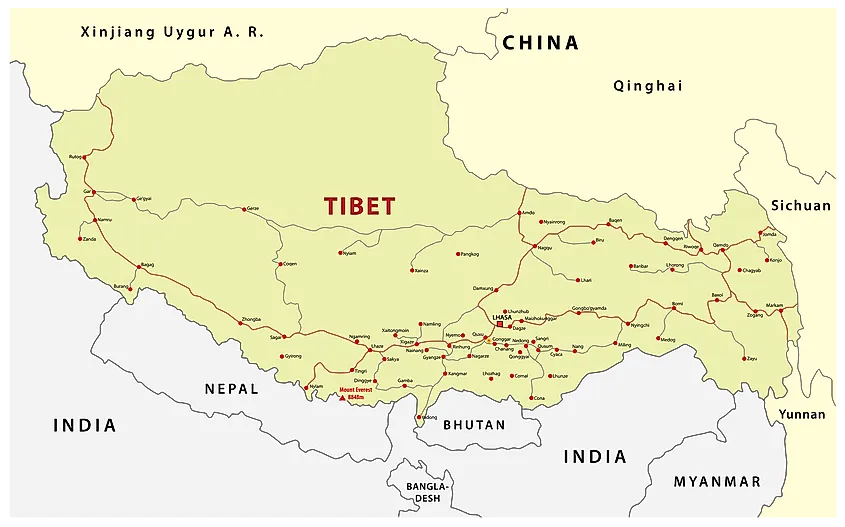International Relations
Central Tibetan Relief Committee
- 09 Apr 2022
- 5 min read
For Prelims: Central Tibetan Relief Committee, TPiE (Tibetan Parliament in Exile), Simla Convention
For Mains: India’s Tibet Policy, Effect of Policies & Politics of Countries on India's Interests
Why in News?
The Union government has extended the scheme to provide Rs.40 crore grants-in-aid to the Dalai Lama’s Central Tibetan Relief Committee (CTRC) for another five years, up to fiscal year 2025-26.
- The scheme provides for an annual grant of Rs.8 crore to CTRC to meet the administrative expenses of Settlement Offices and social welfare expenses for Tibetan refugees staying in Tibetan settlements spread across 12 States/UTs in the country.
What is the Central Tibetan Relief Committee?
- It was launched in 2015. The main objective of the committee is to coordinate Individual, Voluntary Agencies and Indian Government’s efforts to rehabilitate and settle Tibetan Refugees.
- Includes members from each of the 53 Tibetan settlements in India, Nepal and Bhutan.
- Is dedicated to preserving the cultural and religious heritage of Tibet and building and maintaining sustainable, democratic communities in exile.
- Is dependent on generous international assistance from governments, especially India, Nepal and Bhutan, philanthropic organisations and individuals.
- All the CTRC activities are carried out with consent and support from the Board of Directors and approval from TPiE (Tibetan Parliament in Exile).
- The TPiE has its headquarters in Dharamsala, in the Kangra district of Himachal Pradesh according to which over 1 lakh Tibetans are settled across India.
What led to the Exodus of Tibetan Refugees?
- From 1912 until the founding of the People’s Republic of China in 1949, no Chinese government exercised control over what is today China’s Tibet Autonomous Region (TAR).
- Many Tibetans insist they were essentially independent for most of that time and have protested what they regard as China's rule imposed after the People's Liberation Army occupied TAR in 1950.
- The Dalai Lama’s government alone ruled the land until 1951. Tibet was not “Chinese” until Mao Zedong’s People's Liberation Army (PLA) marched in and made it so.
- This has often been described by the Tibetan people and third party commentators as “a cultural genocide”.
- The unsuccessful Tibetan Uprising of 1959, in which Tibetans rebelled in an attempt to overthrow the Chinese government, led to the fleeing of the 14th Dalai Lama to India.
- On 29 April 1959, Dalai Lama established the Tibetan exile administration in the north Indian hill station of Mussoorie.
- It is named the Central Tibetan Administration (CTA) of His Holiness the Dalai Lama, this is the continuation of the government of independent Tibet.
- In May 1960, the CTA was moved to Dharamsala.
What is India’s Tibet Policy?
- For centuries, Tibet was India’s actual neighbour, as most of India’s boundaries and the 3500km LAC is with the Tibetan Autonomous Region, and not the rest of China.
- In 1914, it was Tibetan representatives, along with the Chinese that signed the Simla convention with British India that delineated boundaries.
- However, after China’s full accession of Tibet in 1950, that China repudiated the convention and the McMahon line that divided the two countries.
- Further, in 1954, India signed an agreement with China, agreeing to recognize Tibet as “Tibet region of China”.
- In 1959, following the Tibetan uprising, the Dalai Lama (spiritual leader of Tibetan people) and many of his followers fled to India.
- Former Prime Minister Jawahar Lal Nehru gave him and Tibetan refugees shelter, and helped in setting up the Tibetan government in exile.
- The official Indian policy is that the Dalai Lama is a spiritual leader, and the Tibetan community in India, with more than a lakh exiles, is not allowed to undertake any political activity.
- In the event of increasing tensions between India and China, there has been a shift in India’s Tibet Policy.
- This shift in the policy, earmarks the Indian government actively managing with the Dalai Lama in public forums.







